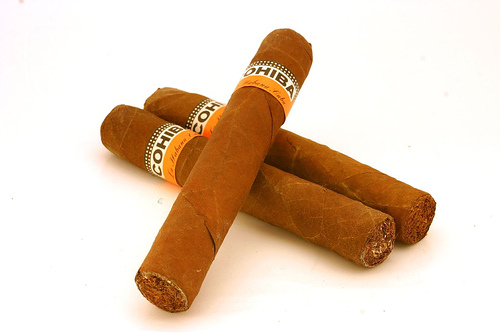
Santa Monica Plans Smoking Ban on Promenade
By Martha Groves
LATimes Staff Writer
July 28, 2006
Santa Monica has opened a new front in the battle against secondhand smoke: the Third Street Promenade.
The City Council voted 5 to 1 this week to order the city attorney's office to write an ordinance that would ban smoking at the promenade — one of Southern California's most popular tourist attractions — as well as at outdoor cafes, automated teller machines, movie ticket lines and farmers markets throughout the city.
Because the ordinance would also prohibit smoking within 20 feet of the entrances to public buildings, it would also effectively mean that pedestrians could not light up on sidewalks in any of the city's business districts, including Montana Avenue and Main Street.
Santa Monica's planned action comes several months after Calabasas made national headlines by effectively banning smoking in most public areas.
But Santa Monica's proposed rules have the potential to affect far more people because of the city's popularity with tourists.
The effort is in keeping with the city's progressive image. Nonetheless, at least one local business leader expressed concern about how foreign visitors would react to an outdoor smoking ban.
"We have a very large number of international tourists," said Kathleen Rawson, executive director of Bayside District Corp., a public-private management company that oversees downtown Santa Monica. "The education of this is going to be a challenge."
She is not alone in wondering whether the measure might be too extreme.
"I'm totally for not smoking in bars and restaurants," said Justin Molitor, 25, a Santa Monica resident who held a Marlboro Light cigarette as he waited to cross Arizona Avenue. "But outside I'm not sure I agree."
Laurence Meurat, a visitor from Paris who was puffing a cigarette as she strolled the promenade, said a smoking ban would not matter much to her. She said she would simply find another place to light up.
Less sanguine was Alex Busto, 35, a resident of Logrono, Spain, who was relaxing with a cup of coffee and a cigarette outside the Borders bookstore on the promenade. Busto said she could understand the smoking ban in enclosed spaces such as restaurants. "But outside on the street, come on! It's like telling people what to do," she said. "Why don't they ban cars, which create so much pollution?"
In Spain, she said, a new rule lets restaurants choose whether to allow smoking. Many have continued to do so, she said, largely because "a lot of people smoke in Spain."
Rachel Schmidt, a nonsmoking tourist from Takoma Park, Md., said outdoor smoking posed less of a risk of secondhand smoke exposure than indoor smoking. Still, she said, the social pressure is growing on smokers to quit, and she suspects there will be "a natural winnowing" as people tire of having to go farther afield to light up.
Then there was Andrea Guardia, 28, a Santa Monica resident who competes in triathlons. Guardia said she would be "very happy" if the outdoor smoking ban passes, as expected. She recently spent an evening at a Hollywood club where patrons were smoking. "When I got home," she said, "my hair, my clothing all smelled of smoke."
The immediate catalyst for the proposed ban was a February report by the California Air Resources Board that classified secondhand smoke as a "toxic air contaminant." The report was the first to focus primarily on outdoor secondhand smoke in California. State environmental health regulators have found that secondhand smoke causes premature births, breast cancer and other deadly illnesses and respiratory diseases.
The board's report followed several federal government studies that established secondhand smoke not only as a carcinogen but also as a cause of heart disease and other serious health problems among nonsmokers, especially children.
Santa Monica city staff members studied dozens of ordinances, most of them from California communities.
"At least 25 cities have partial or complete bans on outdoor dining smoking," said Deputy City Atty. Adam Radinsky. "Ours would be among the most comprehensive."
Among cities that partly or completely prohibit smoking in outdoor dining areas are Berkeley, Long Beach, Palo Alto and Santa Barbara. In March, Calabasas adopted the nation's strongest outdoor smoking restrictions.
Radinsky said Santa Monica targeted the promenade specifically because it is a popular tourist destination that is known worldwide.
"There's a large and growing trend among places like Disneyland and zoos and theme parks to ban outdoor smoking," he said. "Tourists and families begin to expect they will be able to enjoy these places smoke-free." Sea World, Six Flags, Universal Studios, the Hollywood Bowl, the Los Angeles Zoo and Dodger Stadium are among venues that have prohibited smoking, although many of the attractions provide designated areas for smokers.
Radinsky said the city's research showed that smoking bans tend to help tourism. He said the California Restaurant Assn., a trade group, told the city that it would not oppose a ban on smoking at outdoor dining areas.
City Councilwoman Pam O'Connor, who cast the lone vote against the idea, called the proposed ban "a back-door attempt to prohibit smoking."
"The stated public policy of the state of California is to end smoking among Californians," she said. Rather than take a piecemeal approach, she said, "let's bring that debate into the public and do that."
The council could see a smoking-ban ordinance in September. If approved, the ordinance would go into effect about six weeks later, Radinsky said.
"I just don't know where you can smoke anymore," said Suzanne de Almeida, a longtime Santa Monica resident who was enjoying a cigarette on the promenade.
"I don't smoke in my apartment or my car because of my son. I don't do it on the patio because it bothers my neighbors. I guess I'm going to have to quit."
No comments:
Post a Comment